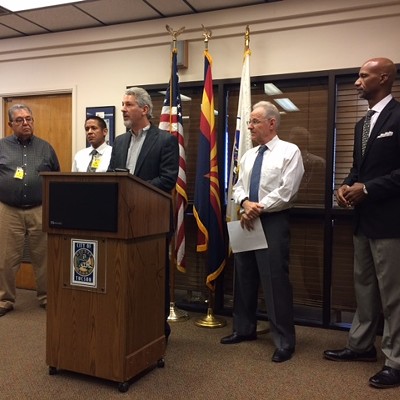That's because city officials cut its irrigation, in anticipation of building a skateboard park here.
Today, after years of spotty funding and assorted mishaps, the project is finally close to breaking ground. But since its inception nearly a decade ago, neighbors have come and gone. And these days, not everyone around Santa Rita remains thrilled with the idea.
Meanwhile, this park is also slated for a master-plan review, as construction crews prepare to widen adjacent 22nd Street. Many see that as a perfect chance to make Santa Rita something special, a sanctuary of walking trails and family-friendly nooks.
Their idyllic vision hardly includes a skate park, says Clinco, a historic-preservation consultant. "When you're talking about sustainability in neighborhoods, our green spaces are such great assets. And now we're going to take this green space and put a huge patch of concrete on it?"
Like many inner-city parks, Santa Rita's modern identity is more about what it does--hosting baseball teams, joggers and homeless folks--than what it is, which is a jumble of competing interests stretching eastward from Fourth Avenue.
Today, those interests are clashing over the skate park. But the deeper challenge is understanding relationships between parks and the people they serve. And that challenge is constantly evolving, as citizens demand more than ever from their public spaces.
While Clinco is a relative newcomer to this mishmash neighborhood of aging homes and stubborn memories, Albert Gallego is an old-timer who recalls every minute aspect of Santa Rita Park history. For more than 50 years, he's lived in a tidy brick house a half-block from its busy borders.
He's also among the residents who worked hard to have a skate park built. And now that their efforts are finally bearing fruit, he sees the newcomers trying to kill it. "Where were they five years ago?" says the retired electrician. "We're just trying to build something for the kids."
In recent months, this spat has devolved into competing petitions, seeking to push the project ahead and stop it in its tracks.
Steve Leal is the city councilman for Ward 5, which includes Santa Rita Park. He's not happy about the skate park fracas. But he's not surprised, either. "It's one of those tension things that necessarily emerges," he says, "once densities and different world views come in to conflict."
It also shows how badly consensus can fray over the years. "Time is the real culprit here," says one observer, noting that many of skate park's original supporters have moved away or simply changed their minds.
The skate park plan itself dates to 1999, when downtown-area teens were polled on the kind of activities that might keep them out of trouble. Topping the list were places for painting graffiti art, for listening to music--and for riding their skateboards.
Following this survey, youth-group Camp Fire USA began agitating for a skate park, and the notion made the rounds of several neighborhoods and numerous parks--where it was repeatedly rejected--until boosters settled on Santa Rita. It seemed like a deal made in heaven: Both the Santa Rita and Armory Park neighborhood associations signed off, and supporters soon received $247,166 in city block-grant funds, as well as another $150,000 from the county.
Then began a series of small disasters. The contractor backed out. Parks Director Dan Felix died, and skate supporters complained that his successor was less enthusiastic about the idea. Meanwhile, the cost of construction materials skyrocketed. In a final blow, Camp Fire--the group behind this venture--closed its Tucson office.
After that, the project languished for years. It was only recently revived, with $369,000 left in the fund. Much of the design was already in place for the 15,390-square-foot park, which is now nearly 7,000 square feet smaller than the original plan.
Suddenly, folks who had never heard of the skate park were up in arms. Aside from all the concrete, they worried that it might add to the area's crime and traffic problems.
Among those worried neighbors is Armando Rodriguez, who steadfastly opposes the skateboard park. He says the city is trying to shove a problem--skateboarders rolling around El Presidio Park and City Hall--onto Santa Rita Park.
"I think they're trying to get rid of them from downtown," Rodriguez says. "And I think it's going to bring a lot of unwanted people to our neighborhood."
But others contend that such recreational facilities are badly needed. They include Peg Weber, an administrator with the Tucson Parks and Recreation Department. She says youngsters who skate at El Presidio are short on alternatives. "The kids need a place to go, and I don't want them criminalized. I like to see these young people helped out."
Weber made the decision to finish Santa Rita's eternally delayed project, despite ongoing disagreements. "Yes, there is some schism in the neighborhoods," she says. "People who had first been involved in the project have a different opinion than the new guys who have come in.
"But I felt, in my professional opinion, that we should move on. This is a project that's been delayed and delayed. Someone needed to make a decision. If that's my fault, then that's what it is."
Councilman Leal says city leaders previously cast about town for a proper skate-park site. They wanted one that was realistically placed, "and not out at someplace like (the eastside) Udall Park, where kids would have to take a bus to get there."
Ten years later, he says, there may be more opposition than before. "But a lot of neighbors in the (Santa Rita) area still want the skate park. At the last neighborhood meeting I went to, there were more people wanting it than not."
However, that still doesn't jibe with Clinco and others, who want to make their park a special spot, rather than just another sports outpost.
"The neighborhood wanted that skate park a long time ago," Clinco says. "But sometimes, you need change. I've talked to my neighbors, and many of them seem less and less inclined to want skateboarding in the park."
Meanwhile, from his house a half-block away, Gallego admits that this tussle has been frustrating. "It's left a bitter taste," he says. "But I guess everybody has their own way of looking at things."












